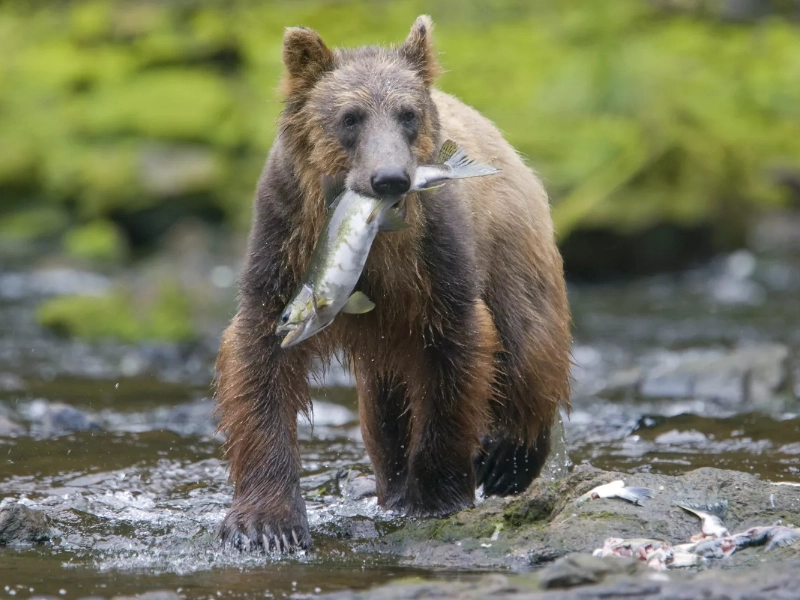8 Completely Unique Types of Bears
3. The Versatile Brown Bear: A Global Presence

Living over North America, Europe, and Asia, the Brown Bear (Ursus arctos) is among the most often found and flexible bear species on Earth. For millennia, this amazing animal—known for its great strength and size—has captivated humans and been central in folklore, mythology, and contemporary conservation campaigns. The brown bear's great versatility helps it to flourish in a wide range of habitats, from arctic tundra and even semi-desert areas to deep forests and alpine meadows.
Brown bears' coat colour is one of the most remarkable aspects; it varies greatly even if the species name suggests otherwise. Although many people do have brown fur, brown bears have a colour pallet ranging from a light cream or blonde to deep chocolate and even nearly black. Not only is this variety in coat colour aesthetically pleasing, but it also offers significant hiding benefits in many habitats. For example, whereas darker individuals are usually found in forested areas, lighter-colored bears are more numerous in open, dry habitats.
Brown bears are famously physically strong. Their great strength and excellent endurance—qualities that will help them much in their sometimes demanding surroundings—are well known. With some remarkable exceptions, adult male brown bears—also known as boars—can weigh anything from 300 to over 1,500 pounds (136 to 680 kg. Usually weighing between 200 and 800 pounds (90 to 363 kg), females—also known as sows—are often smaller but still powerful. Common among bear species, this sexual dimorphism functions in their social and reproductive activities.
The annual cycle of brown bears, which includes a period of protracted lethargy throughout the winter, is among the most amazing features of their behaviour. Depending on their geographic location and local temperature, brown bears undergo a condition sometimes known as hibernation from October to December. Still, this period of inactivity is not like actual hibernation observed in certain other species. Brown bears can drop their body temperature and heart rate during this period, although not to the extremes seen in actual hibernators. This adaptability lets them keep the capacity to react to dangers or disturbances while yet conserving energy during periods of food shortage.
Getting ready for this winter dormancy is an amazing natural effort. Brown bears go into a phase known as hyperphagia in the months before their winter hibernation, during which they significantly consume more food to create reserves of fat. A bear might eat up to 90 pounds (40 kg) of food daily and gain over 3 pounds (1.36 kg) of body weight over this period. Survival depends on this phase of heavy feeding since the fat reserves built during fall must keep the bear through many months of inactivity.
Brown bears have a diet as varied as their habitats and are opportunistic omnivores. Although they will eat practically everything edible, their diet usually comprises of plant stuff mixed with animal protein. Brown bears might eat grasses, sedges, roots, berries, nuts, insects, fish (especially salmon), and even bigger mammals depending on the season and habitat. Usually most active in the morning and evening, their foraging behaviour helps them avoid the heat of noon and maybe lessens competition with other predators.
Another amazing feature of brown bear behaviour is their great distance-traveling search for food. This is especially clear during salmon runs when bears might gather in great numbers around rivers and streams. These meetings give a unique chance to see social interactions among usually lonely creatures. Although brown bears usually avoid close contact with one another outside of mating season, the amount of food during salmon runs might cause brief tolerance of proximity to other bears.
Though they are somewhat large and strong, brown bears are not usually hostile to people unless startled or provoked. Female bears with cubs are known to be very protective, though, and may respond defensively should they see a threat to their young. This defensive behaviour has helped to explain the bear's reputation in human mythology and guided the creation of particular safety rules for those living in or visiting bear habitat.
Brown bears and human civilisations have had a complicated and frequently tense connection. Human populations have grown into bear areas, hence interactions between the two species have become more common. Given habitat loss and fragmentation still endangering brown bear populations in many areas of their range, this has made conservation efforts difficult. Many nations have launched effective conservation initiatives in spite of these difficulties, which has resulted in either steady or even rising brown bear numbers in some locations.
All things considered, the brown bear is evidence of the adaptation and fortitude of environment. From their extensive range to their different diets and amazing physical prowess, these animals enthral both scientists and outdoor enthusiasts equally. The more we know about these amazing animals, the more evident it is that their preservation benefits not only the species but also the general balance and health of the ecosystems they call home.
Advertisement
You May Like

